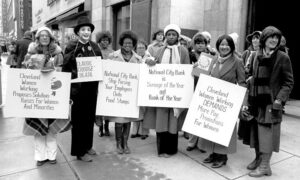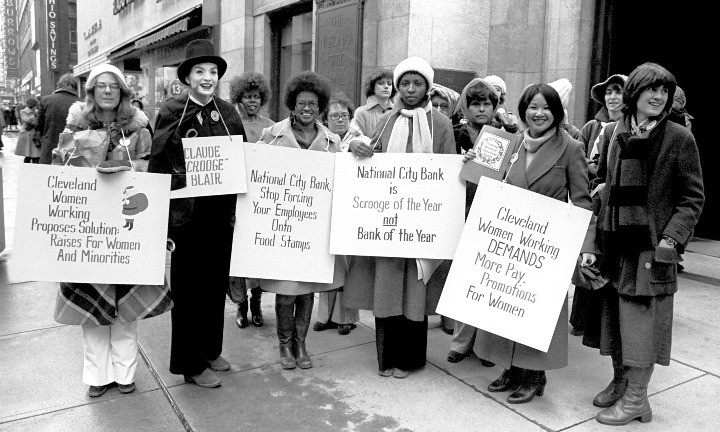Movie Info
Movie Info
- Director
- Julia Reichert and Steven Bognar
- Run Time
- 1 hour and 29 minutes
- Rating
- Not Rated
VP Content Ratings
- Violence
- 1/10
- Language
- 1/10
- Sex & Nudity
- 2/10
- Star Rating
Relevant Quotes
Then I will draw near to you for judgment; I will be swift to bear witness against the sorcerers, against the adulterers, against those who swear falsely, against those who oppress the hired workers in their wages…
Thus says the Lord: Act with justice and righteousness, and deliver from the hand of the oppressor anyone who has been robbed.
They let you dream just to watch ’em shatter
You’re just a step on the boss-man’s ladder
But you got dreams he’ll never take away
You’re in the same boat with a lotta your friends
Waitin’ for the day your ship’ll come in
An’ the tide’s gonna turn and it’s all gonna roll your way

Julia Reichert and Steven Bognar, creators of American Factory, have done it again! They have gifted us with another riveting documentary about an important issue in America, the unequal treatment of women in the workforce, specifically in the office where millions of them continue to be underpaid and subject to sexual discrimination, even harassment. If you liked Norma Rae, whose iconic photo of her defiantly holding up the “Union” placard we see several times in this documentary, you will love this film—especially midway into it when we Jane Fonda describes her experience with the Cleveland 9to5 women whom she spoke with while doing research for her own film, and then we hear Dolly Parton sing her hit song “9 to 5.”
Chief among the many office workers interviewed are Karen Nussbaum and Ellen Cassidy, the founders of the 9to5 movement during the early 1970s. They describe their situation in Boston where they worked at the usually enlightened Harvard. But here too clerks and secretaries worked at low wages and amidst their bosses’ expectations that their careers outside the home were temporary, yielding to housewifely chores once they snagged husbands. Indeed, the bosses regarded their secretaries as a combination of servant and wife, expected to fetch coffee between typing memos and running other personal errands. And they had better possess great tolerance for sexual harassment. Also, become pregnant, and be shown the door. A boss could terminate a woman for any reason (or none given), and a woman had no recourse. This was a male dominated culture in which women were devalued. One of the women interviewed remembers her father telling her, “Girls who are walking encyclopedias should remember that reference books are never taken out.” (My wive often repeats with sadness her mother’s advice to her during high school days—don’t make such high grades or you won’t attract a boy! And although she didn’t experience sexual harassment, she remembers training several young men at the home loan agency where she worked, and they were soon promoted, but never an offer to her.)
Following Karen Nussbaum and Ellen Cassidy’s dissatisfaction with their workplace mistreatment, the genesis to the 9 to 5 movement was the newsletter founded by Karen and Ellen, which provided information and encouragement, and then meetings which brought the oppressed women together face to face. During the reminiscences of the many interviewees a few clips from Mad Men and Mary Tyler Moore are inserted, reflecting the general demeaning viewpoint toward women office workers of the times. Their advocacy group drew attention from women all over the country, and 9to5 was soon spread to Cleveland.
As the now activist Karen and Ellen reveal, they had to deal with women who were opposed to the Feminist Movement so that they had to change their language in addressing them. The called the women to participate in “actions” rather than “protests.” They also had to overcome the racism of some of the workers by helping them to see that both whites and blacks were being exploited and treated with disrespect.
For many viewers, Jane Fonda’s appearance well into the film will be a highlight as she describes her research for background information for her movie 9 to 5. Already an anti-war activist, notoriously so in the eyes of many veterans, she sympathized with the plight of the women whom she was interviewing. She reports that she asked if any of them had ever fanaticized killing her boss, and the hands of every woman in the group shot up. Several described what they would like to do to their over-bearing boss, and thus the plot centered on the kidnapping of the arrogant boss in the film was handed to Jane, who apparently passed it on to the three screenwriters of her movie. Then Dolly Parton wrote the song that became the film’s theme song and provided the workers with an anthem for their movement. What a wonderful addition to an already interesting film!
The women decided they need to move from mere advocacy to becoming an organized group powerful enough that management would have to negotiate with them. In other words, they realized they needed a union. Their fiercest battles really begin, the women losing the required elections at first, and then through persistently making personal contacts with clerks and secretaries, starting to win. Their demands, gleaned from thousands of returns on their surveys of the office workers, boiled down to four major concerns: Better pay, job descriptions, respect, advancement opportunities, and an end to sexual harassment.
The Hollywood film was of great help, but the year of its release also saw the election of President Reagan, who was to have a hugely detrimental effect on unions. In 1981 when the Professional Air Traffic Controllers Organization refused to end their strike, the President fired most of them. His decision, supported by the public, injected a deep chill into the union movement so that membershp began its steep decline that continues to this day. Thus, the last part of the film, though reporting some small victories, becomes darker as the women face the enormous power of the male business establishment. The statistics at the end showing how different groups of women lag behind men in their pay is a sad commentary on the slow progress that has been made through the years of struggle and sacrifice.
That the issues raised by our pair of filmmakers is not trivial is in agreement with the Jewish/Christian Scriptures. Although some religious leaders would deflect its readers by promises of heaven, the cry for the just payment of ages springs right from the Scriptures, as can be seen by searching the Torah itself and the prophets—see Leviticus 19:13; Deuteronomy 24:14-15, Jeremiah 22:13, and Malachi 3:5. Of course, the Scriptures are concerned not just with justice and wage, but with all forms of oppression committed by the powerful—just do a word search of various forms of “oppress” and see how many passages turn up! Yes, once again filmmakers join the company of the prophets decrying wrong and issuing a challenge to work for justice. Be sure to join what I hope will be a large audience on the night of February 1 when the Independent Lens will present this timely documentary on PBS at 10 PM (EST—times may vary around the country. Check with your local station.)
This review will be in the February issue of VP along with a set of questions for reflection and/or discussion. If you have found reviews on this site helpful, please consider purchasing a subscription or individual issue in The Store.

